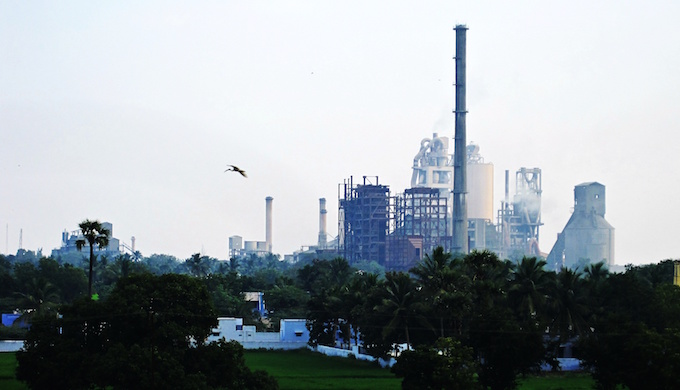The global cement industry, one of the primary producers of carbon dioxide, needs to make serious structural changes to meet emission targets set at the Paris climate summit

A cement factory in southern India (photo by Thangaraj Kumaravel)
India’s three large cement makers have significantly reduced emissions among the top 12 producers of the building material in the world, a report revealed on Thursday, pointing the way for this heavily polluting sector to make structural changes to shrink its carbon burden.
The international cement industry, responsible for as much as 5% of the world’s carbon emissions, requires significant innovations to bring itself in line with the objectives framed at the climate change meeting held in Paris in December 2015, according to the June 9 report by London-based non-profit CDP, a consultancy formerly known as the Carbon Disclosure Project.
“This is the first piece of major research to break down how major players in the cement industry are meeting the challenge of reducing emissions in line with the science called for by the Paris Agreement,” Tarek Soliman, senior analyst, investor research, CDP, said in a statement.
Holcim, Shree Cement and Lafarge rank highest on carbon-related metrics, the report found. However, even the recently merged LafargeHolcim, which ranks the highest, is vulnerable without significant additional innovation, CDP said. Worryingly, more than 50% of the facilities studied are located in areas of water stress exacerbated by climate change.
The report analysed a USD 120 billion grouping of the world’s largest cement companies. Of the 12 global cement companies analysed, the worst performers face a potential earnings hit of 114% of their operating profit even at a low USD 10 carbon price.
“As carbon-related regulatory measures inevitably tighten and the carbon price signal strengthens, investors will expect both strategic and rapid changes from cement companies, including better use of currently available options as well as investment in longer–term ones, whether this be in areas such as low-carbon product development or the deployment of carbon capture, use and storage,” Soliman said.
In order to be consistent with the Paris Agreement, cement companies must increase their use of alternative fuel sources, implement thermal energy efficiency measures and use decarbonized substitute materials to a much greater degree, the CDP report recommended.
Only three companies out of the 12 in the report have outlined plans for reducing their emissions in line with global carbon budgets, which are targets based on scientific advancement, CDP found. The other companies’ plans are not ambitious enough, it said.
With the Paris Agreement driving towards net zero emissions in mid-century, cement companies have a historic opportunity to set targets that can future-proof their business, the report said.
